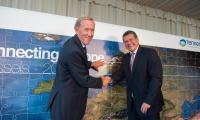
An interview with Mel kroon
Mel Kroon, former CEO of TenneT, realized early on that big steps had to be made in order to meet the carbon emission goals in Europe. He is the man that origi-nally came up with the idea of the North Sea Wind Power Hub. We interviewed Kroon about his motivations.
Why are you such a big advocate of wind energy?
“I am not just an advocate of wind energy but wind energy is a means to satisfy a social requirement. Governments have signed a Climate Agreement to be CO2-neutral in 2050. We have to take steps to fulfill this obligation. In this respect, a windpark at sea is an attractive option. It enables a spectacular cost reduction. In fact, the latest outcome of a tender for a large wind farm in the North Sea, shows it can be built without any subsidy. Through a smart approach many windturbines can be built in the North Sea, as long as you find the right balance between energy, nature and efficiency. Through smart collaboration between stakeholders, we can meet our climate goals in a fantastic way.”
When did the idea for the North Sea Wind Power Hub arise?
“I can’t say there was one particular ‘Eureka moment’. We just explored different options and combined useful elements. At TenneT, we have experience in connecting offshore wind-farms. This requires high investments, particularly when they are located far into the sea, which makes it relatively expensive and requires a high degree of technical capacity . The first preference is to build a windfarm relatively close to the coast. That way, we can use alternating current and shorter cables. But at a certain moment there won’t be locations close to the coast available anymore. We have to get further offshore. Which brings us to the challenge; How we can realize that offshore grid connection without much higher costs for society?”
How do you do that?
“It comes down to a few conditions. First of all, look for shallow water. You could build an island instead of a platform. In Germany, TenneT uses ‘jackets’: Steel constructions underneath on which we build an offshore convertor. Another way to reduce cost, is to give the hub a second purpose. The infrastructure for transporting wind energy is only being used when there is wind. When there is little or no wind, you can use the cables for trading electricity between the markets in the surrounding countries; The Netherlands, Germany, Denmark, Norway, UK and Belgium. With this Hub (island) and Spoke (cables) concept, a connecting infrastructure to different countries is being created to exchange electricity. In this way, the effective use of offshore grid connections can double and the same investment suddenly becomes much more valuable. And finally, a hydrogen plant could be installed on the island, which turns wind energy into green hydrogen and transports this hydrogen through a pipeline to the main land. The green hydrogen can be used to make other sectors like heavy transport, aviation and the fertilizer industry more sustainable.”
What is your personal motivation to come up with solutions for future energy supply?
“I welcome the challenge to come up with solutions for matters like these. To think outside the box. I like to seek ways to keep costs as low as possible, essential for social acceptance of renewable energy. The art of creating new ideas is to be curious about other disciplines than yours. Also, you need to have a mindset to keep trying new things. To always wonder: How can we do this differently? This kind of thinking is necessary in order to achieve significant breakthroughs. If you keep doing things the way you’re doing them now, you will reduce some costs because it becomes a routine. But you will never realise a spectacular cost reduction.”
What message do you want to convey to all those interested in the North Sea Wind Power Hub?
“I see a lot of enthusiasm and energy. Excellent people who will further develop our ideas and solutions. Some elements of the NSWPH concept might be implemented sooner than expected. Let’s further explore the Hub and Spoke concept.”
